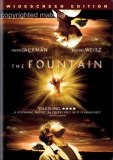| Reviews & Columns |
|
Reviews DVD TV on DVD Blu-ray 4K UHD International DVDs In Theaters Reviews by Studio Video Games Features Collector Series DVDs Easter Egg Database Interviews DVD Talk Radio Feature Articles Columns Anime Talk DVD Savant Horror DVDs The M.O.D. Squad Art House HD Talk Silent DVD
|
DVD Talk Forum |
|
|
| Resources |
|
DVD Price Search Customer Service #'s RCE Info Links |
|
Columns
|
|
|
Fountain, The
THE MOVIE:
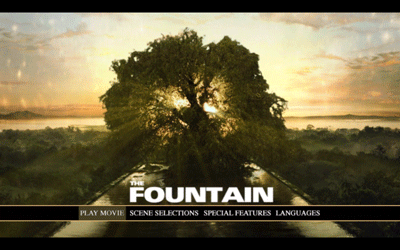
Darren Aronofsky's The Fountain was barely a blip in theatres during its release last year. A willfully challenging art-house picture with the shine and substance of a sci-fi brainteaser, it was a conundrum to some, a yawner to others, and a revelation to many. It's the kind of movie that was made to be debated and argued over, defended and loathed in equal measures.
I missed it at my Cineplex, instead catching it on a transatlantic flight. Not exactly the most ideal of situations to watch a film, particularly one as beautifully shot as The Fountain, but even viewing it on a tiny picture screen on the back of someone else's chair could not dull Aronofsky's fervor. I was instantly enthralled, joining the "loved it" camp without reservation. This was a surprise to me, because I wasn't necessarily predisposed to like it, having mixed feelings about both of Aronofsky's previous efforts, Pi and Requiem for a Dream. It was as if I had been sleeping, unwilling to believe, and The Fountain struck me both intellectually and emotionally, hitting with the force of an awakening slap. The Fountain is a passionate movie, and it moves with the inconstant waves of human feeling. For as much as it tickles the philosophical centers of the viewer's brain, if you try to intellectualize it too much, you'll lose it. You just have to let it happen and accept the irrational flow. The Fountain is about grief, about life and death, about sacrifice and the act of creation through reduction. Don't try to force the pieces together; the movie will assemble the puzzle for you.
Darren Aronofsky's script, written from a story conceived with Ari Handel, runs on three separate but intersecting timelines. The main line is in the present, where Dr. Tommy Creo (Hugh Jackman) is searching for a cure for cancer. He is driven and obsessed, determined to outrun the tumors that threaten to take his beloved wife away from him. For her part, Izzy (Rachel Weisz), indulges his dream. She yearns to spend more time with her husband, but she understands his compulsion. As a writer, she is trying to solve her own riddles about death. Her work-in-progress is a book called The Fountain, a period piece about a Spanish conquistador named Tomas (Jackman, again) searching for a Mayan temple believed to hold the Tree of Life from the Garden of Eden, which is, essentially, the Fountain of Youth. Tomas was sent on the mission by Queen Isabela (Weisz), who seeks eternal life for herself and her kingdom. Adding a perilous deadline to Tomas' expedition is the Inquisitor (Stephen McHattie, 300), a power-mad zealot who is spreading through Spanish society like the cancer that attacks Izzy. He'd have Isabela killed if it meant taking the throne himself.
We see the Spanish storyline played out as Tommy reads the manuscript, its narrative intertwining with his scientific mission. Izzy explains to him the various Mayan creation and afterlife myths she's uncovered in her research, and it inspires Tommy to seek different techniques. All the while, the third timeline, the future, runs its own course over the top of both of the other stories. This story is the most open to debate, possibly being another part of the book, but also possibly more connected to Tommy's consciousness.
In this future, Jackman plays a monastic caretaker for a tree that grows at the center of a star, its similarity to both the Tree of Life and the star that the Mayan's believe houses their souls after they die being immediately apparent. From where I sit, this symbolic plotline is a manifestation of Tommy's thoughts, of his inspiration and his guilt. The answers he seeks (and make no mistake, the questions change, it's not as simple as all that) lie in somehow connecting this future story to the rest, steering the star to the Mayan temple and Izzy's hospital bed and not necessarily halting death, but at least finding some kind of understanding.
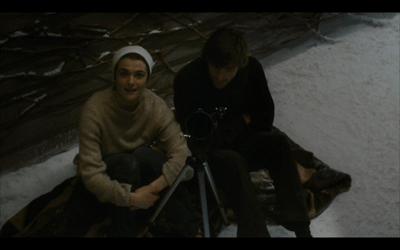
A synopsis of The Fountain reads like a recipe for something pretentious and self-important. In Aronofsky's kitchen, the movie is a delicate soufflé. All it would take is a loud rejection from his viewer to make it collapse on itself. Note that I put the survival of the picture in the audience's hands. It's because I think the director has given us all the pieces, all of the information we need to connect everything in his tale. He's perfectly in control of a rather unwieldy narrative, and he gingerly leads his audience from one element to the next. He makes the interweaving of the three lines apparent through repetition of events and dialogue, but he also uses visual rhymes to add resonance. For instance, as both Tommy and Tomas head off on their quest to save their beloved, they enter the shot upside down and exit right-side up, or the hairs on the back of Izzy's neck resemble the living filaments on the tree within the star; there is also similar framing used on the various characters, recurring images of rings and spheres, and design motifs that echo, such as the Mayan dagger and the screen in front of Isabela, brain scans and nebula patterns, and the jewelry worn by Isabela and Izzy.
The art direction in The Fountain is meticulously gorgeous. Aronofsky insisted on hand-crafted, live effects wherever possible, and the end product is more lush than any big-budget CGI-fest. More important than the visual details, though, is the heart that pumps the blood through this picture. Aronofsky never loses sight of the emotional impact that keeps The Fountain from being just an empty mind-bender that's more satisfying to look at than it is to watch. Here is where casting is oh so important. Hugh Jackman had already had a hell of a year with a comedic performance in Scoop and playing the conflicted hero (villain?) in The Prestige, and his turn as the lead in The Fountain adds an even greater mark to his resume. He's never had so much passion onscreen, and as bright as his fire burns when he chases the various relics of his quest, the explosion of despair that follows tears everything down and razes the emotional landscape. You'd be forgiven for thinking that nothing more can grow there, but Aronofsky and Jackman still have a few surprises up their sleeves.
Of course, no obsession is complete without its central, driving object, and Weisz is resplendent as the muse. Izzy/Isabel is the less showy role. As much as she is the inspiration that pushes the explorers to action, she is also the finish line. She already knows what they will find, and she is required to provide both sympathy and encouragement even as she disintegrates. Rachel Weisz is more than emotionally able as an actress, and I have no trouble buying that she could be the catalyst for world-spanning expeditions and sleepless nights in search of salvation.
Needless to say, I loved The Fountain. Every defiant, arty minute of it. It took about six years for Aronofsky to bring the film to life, and even the crushing blow of one production being shut down just as it was getting started couldn't stop him. Just like the character in his script, he wasn't going to let anything prevent him from pursuing his journey all the way to the end. I'd say I'd like to know how that felt, what kind of buzz he achieved by fulfilling that dream, but it's all right here on the DVD in the final scenes of the movie. The rush of innovation, the joy of understanding, the contentment of spiritual nirvana--author and creation are, for once, occupying the same space. Tommy's fictional discovery is Aronofsky's artistic discovery playing on an endless loop, growing exponentially with each play, like a chain reaction of supernovas. Like the Fountain the characters all seek, The Fountain is Aronofsky's source of eternal life--a motion picture that will endure.
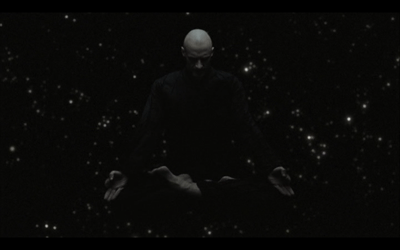
THE DVD
Video:
If the visual beauty of The Fountain couldn't be muted on an airplane monitor, then imagine how wonderful it must look on DVD. Warner Bros. has given Aronofsky's movie its full due. The image quality is excellent, preserving the director's fantastic interplay of light and shadows, an ocular manifestation of the issues of life and death that fuel his story.
Sound:
Viewers can choose between the original English audio and an alternate track in French (dubbed in Quebec, apparently), both mixed in 5.1. The English has a solid balance and good interplay amongst the speakers, highlighting the film's exceptional score without sacrificing dialogue audibility.
There are also subtitles in English, French, and Spanish.
Extras:
In addition to the standard inclusion of a trailer, the DVD of The Fountain also has a six-part documentary about the various stages of production on the film. "Inside The Fountain: Death and Rebirth" begins with the ill-fated first go-around and then follows Aronofsky's reconfiguring of the project and the actual filming of the picture. Like the movie itself, the latter half of the documentary is broken down to focus on the various narrative lines (past, present, future) in the movie. Overall, this feature keeps the artful tone of an Aronofsky movie while at the same time not shying away from moments of humor on the set. I was particularly amazed to see the construction and live performance of some of the more awe-inspiring special effects. In all, the program runs a little over an hour.
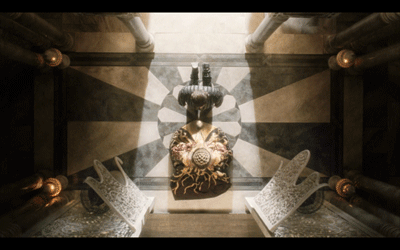
Some of you out there may grumble that there is no director's commentary, but I actually prefer that a film as open to interpretation as The Fountain be left unexplained. I would think it would be counterintuitive for a writer like Aronofsky, who clearly has put so much into creating a unique narrative that leads his audience through various philosophical concepts and moments of intellectual provocation, to lay out his goals in any obvious ways, and a commentary would provide too much information, as far as I'm concerned. (It's also why I don't cry over the lack of a special edition of Spike Jonze and Charlie Kaufman's Adaptation.) Maybe a track with scholars, scientists, and/or philosophers discussing The Fountain would have been nice, though.
I'm actually more surprised that there is no mention made on the disc of the graphic novel version of The Fountain. The original production of the movie was going to have twice the budget of the movie Darren Aronofsky made, and after he scaled back the approach, he worked with painter Kent Williams to make a full-length comic book of the original script. For anyone who enjoyed the movie, the Fountain graphic novel is well worth seeking out. It offers an alternate version of the story while deepening one's understanding of the finished movie.
The DVD case also contains an insert advertising the excellent soundtrack for The Fountain, which features music written by Clint Mansell and performed by the Kronos Quartet and Mogwai.
FINAL THOUGHTS:
Highly Recommended. While acknowledging that The Fountain may not suit everyone's fancy, I still advocate that everyone should see it. Darren Aronofsky has written a script that is philosophical, spiritual, and emotional, and he has somehow dressed it up in truly gorgeous clothes without disappearing up his own behind in a fit of pretentiousness. Working with marvelous performances by Hugh Jackman and Rachel Weisz, the director has made a movie that is both a heady rush and emotionally powerful, giving us a feast for our eyes while also stimulating our brains and our hearts. A very rare treat.
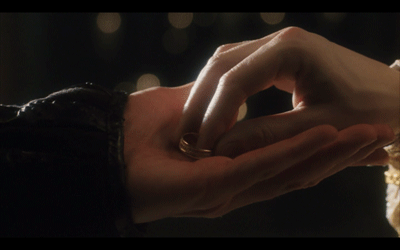
Jamie S. Rich is a novelist and comic book writer. He is best known for his collaborations with Joelle Jones, including the hardboiled crime comic book You Have Killed Me, the challenging romance 12 Reasons Why I Love Her, and the 2007 prose novel Have You Seen the Horizon Lately?, for which Jones did the cover. All three were published by Oni Press. His most recent projects include the futuristic romance A Boy and a Girl with Natalie Nourigat; Archer Coe and the Thousand Natural Shocks, a loopy crime tale drawn by Dan Christensen; and the horror miniseries Madame Frankenstein, a collaboration with Megan Levens. Follow Rich's blog at Confessions123.com.
|
| Popular Reviews |
| Sponsored Links |
|
|
| Sponsored Links |
|
|
| Release List | Reviews | Shop | Newsletter | Forum | DVD Giveaways | Blu-Ray | Advertise |
|
Copyright 2024 DVDTalk.com All Rights Reserved. Legal Info, Privacy Policy, Terms of Use,
Manage Preferences,
Your Privacy Choices | |||||||









